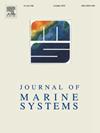Traits associated with food web structure in lagoon and reef ecosystems
IF 2.5
3区 地球科学
Q2 GEOSCIENCES, MULTIDISCIPLINARY
引用次数: 0
Abstract
The oceans are currently facing multiple anthropogenic threats, such as overexploitation, pollution, habitat destruction, and climate change. To address these challenges, ecological indicators are needed to monitor the impact of human activities and assess the effectiveness of conservation measures. Food web topology captures the entire community structure, providing systems-based indicators of ecological status rather than monitoring single species and their composition. In this study, the association between functional organismic traits and topological indices describing the food web structure was tested by using network analysis in 4 reef and 15 lagoon Ecopath with Ecosim models. We aimed to understand if traits and conservation status can be linked with specific network position of a node. We analyzed 3 traits (diet, fertilization type, substratum), conservation status, and 18 topological indices. The results showed at least two significant associations for each trait. Conservation status, fertilization type, and diet displayed more distinct aggregations, being relevant in explaining food web structure. Conservation status aggregated top predators in a risk position (endangered or vulnerable) and also those with fewer network connections. Fertilization type (external, internal, or asexual) could be considered a good grouping trait. Diet has the highest coverage and revealed expected patterns, which can be very helpful for environmental predictions under disturbances, using the trait-based approach. Substratum is the least useful trait for this approach. The associations of ecological traits and topological indices in lagoon and reef food webs might help in conservation “ecosystem-based” management decision-making and prioritization.
泻湖和珊瑚礁生态系统中与食物网结构相关的特征
海洋目前正面临多重人为威胁,如过度开发、污染、栖息地破坏和气候变化。为了应对这些挑战,需要生态指标来监测人类活动的影响并评估保护措施的有效性。食物网拓扑捕捉整个群落结构,提供基于系统的生态状况指标,而不是监测单一物种及其组成。本研究利用Ecosim模型对4个珊瑚礁和15个泻湖生态生物进行网络分析,验证了功能生物性状与描述食物网结构的拓扑指标之间的相关性。我们的目的是了解性状和保护状态是否与节点的特定网络位置有关。分析了3个性状(日粮、施肥类型、基质)、保存状况和18个拓扑指标。结果显示,每个性状至少有两个显著的关联。保护状况、受精类型和饮食表现出更明显的聚集,这与解释食物网结构有关。保护状态汇总了处于危险位置(濒危或脆弱)的顶级捕食者以及网络连接较少的捕食者。受精类型(外部、内部或无性)可以被认为是一个很好的群体性状。饮食具有最高的覆盖率和揭示的预期模式,这对使用基于特征的方法进行干扰下的环境预测非常有帮助。基质是这种方法最没用的特征。泻湖和珊瑚礁食物网的生态特征和拓扑指数的关联可能有助于保护“基于生态系统”的管理决策和优先排序。
本文章由计算机程序翻译,如有差异,请以英文原文为准。
求助全文
约1分钟内获得全文
求助全文
来源期刊

Journal of Marine Systems
地学-地球科学综合
CiteScore
6.20
自引率
3.60%
发文量
81
审稿时长
6 months
期刊介绍:
The Journal of Marine Systems provides a medium for interdisciplinary exchange between physical, chemical and biological oceanographers and marine geologists. The journal welcomes original research papers and review articles. Preference will be given to interdisciplinary approaches to marine systems.
 求助内容:
求助内容: 应助结果提醒方式:
应助结果提醒方式:


